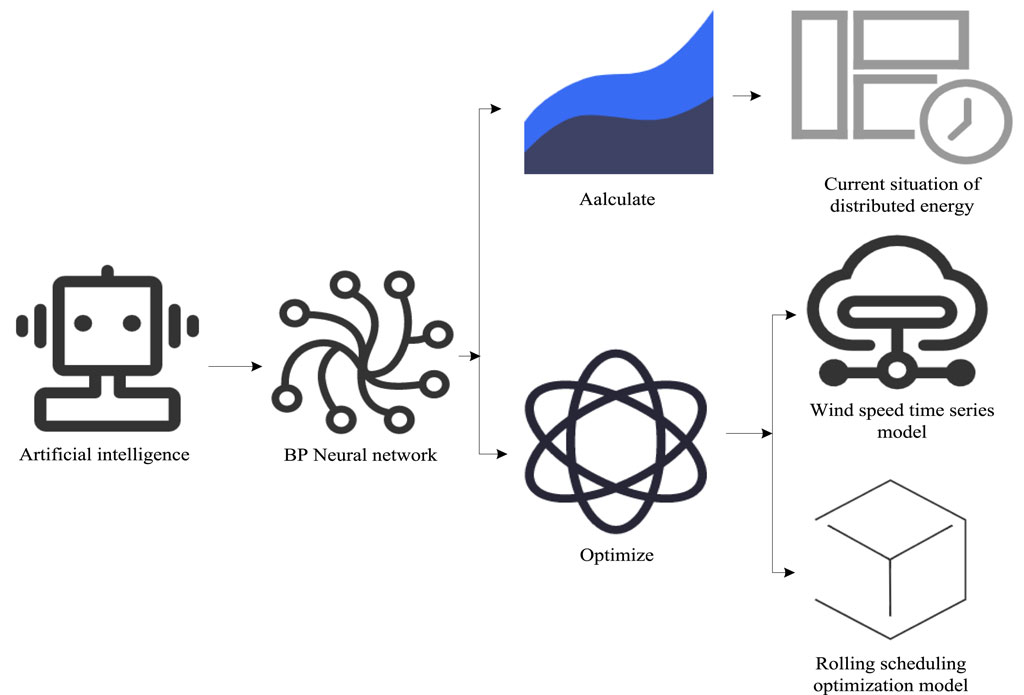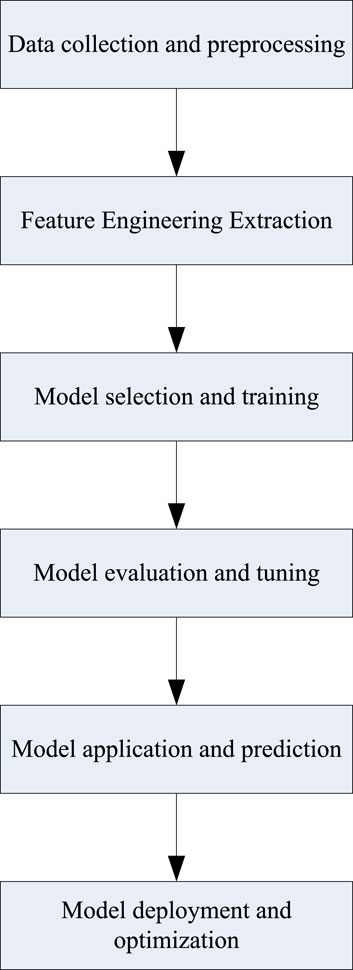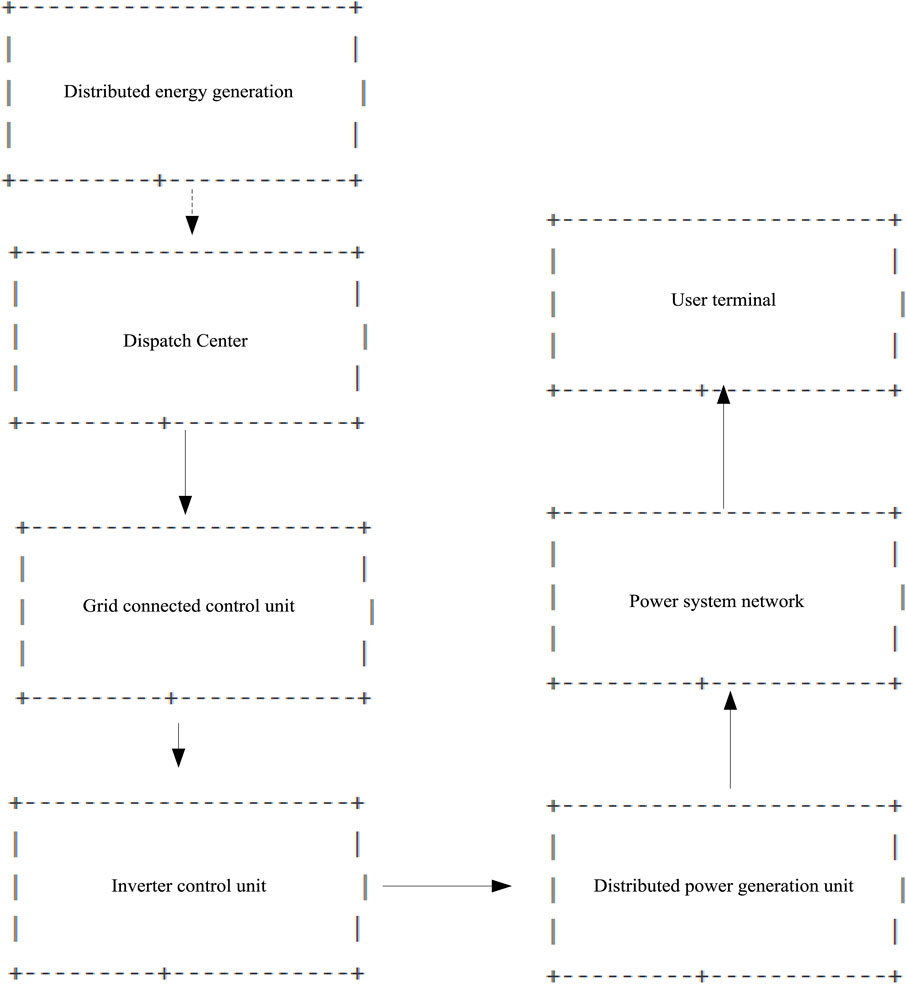- Yunnan Power Grid Co., Ltd., Dehong Power Supply Bureau, Dehong, Yunnan, China
New energy power generation has strong randomness and volatility. Especially in the case of a high proportion of NE (network security) power generation, its sudden random power generation in a short period of time will seriously affect the stable operation of the power grid. Therefore, this paper proposes BP neural network algorithm to study the distributed NE grid-connected cooperative operation control technology. First of all, this paper studies the artificial intelligence algorithm in detail and applies it to the coordinated operation control of distributed NE grid-connected; then, based on the status quo of renewable energy PG (power generation), this paper establishes a suitable wind speed time series model, and thus proposes an optimization model based on a rolling scheduling optimization algorithm. The experimental results show that the average running time of the rolling scheduling optimization algorithm is maintained at about 0.2 s, which can effectively realize online operation. In addition, through rolling adjustment, the error between the total output curve of the unit and the actual total output curve of the unit can be significantly reduced. The research shows that the rolling scheduling optimization algorithm has a good optimization effect, can promote the coordinated development of wind farms and power systems, and increase the capacity of power systems.
1 Introduction
Distributed NE grid connection is an important way to replace traditional energy with clean energy. However, due to the instability and uncontrollability of NE, the coordinated operation and control technology of distributed NE grid connection faces challenges. As a new intelligent technology, AI (Artificial Intelligence) algorithm has powerful data processing and analysis capabilities, which can effectively solve the coordinated operation control problem of distributed NE grid connection. The research on coordinated operation and control technology for grid connection of distributed NE can reduce energy consumption and emissions, which is of great significance for achieving clean energy and sustainable development. The application of AI algorithms can achieve accurate prediction, intelligent scheduling, and optimal management of distributed NE, and improve the reliability and economy of the system, so as to achieve efficient and stable operation of distributed NE. The application of artificial intelligence algorithms can achieve accurate prediction, intelligent scheduling, and optimized management of distributed network elements. Specifically, by learning and analyzing historical data, the system can accurately predict the behavior of distributed network elements in terms of future output power, volatility, and other aspects. On this basis, intelligent scheduling algorithms can reasonably arrange the operation mode and output level of distributed network elements based on the needs and constraints of the power system, in order to achieve system stability and economy. Optimizing management algorithms can further improve the efficiency and performance of the system by optimizing the configuration, operational strategies, and interoperability of distributed network elements. There are two main reasons why artificial intelligence algorithms can provide better results. Firstly, artificial intelligence algorithms can process a large amount of complex data and learn and discover potential patterns and patterns from it. This enables the system to more accurately predict the behavior of distributed network elements and make corresponding scheduling and management decisions. Secondly, artificial intelligence algorithms have the characteristics of adaptability and intelligence, which can be optimized and adjusted according to the real-time state and requirements of the system, thereby improving the flexibility and response speed of the system. In addition, the research and application of AI algorithms is also an important direction in promoting the construction and development of smart grids. With the continuous development and application of AI algorithms, it is possible to achieve comprehensive intelligent management and optimal scheduling of power systems, and improve the security, stability, and economy of power systems, so as to lay the foundation for the construction and development of smart grids.
The coordinated operation and control technology of distributed NE grid connection is an important research direction. With the continuous increase of the installed capacity of distributed NE, its impact on the stability and security of the power grid is also increasing. A key issue that has not yet been resolved is: How to stimulate coordination between large amounts of distributed energy? Each energy source has a different owner and characteristics. Virtual power plants and Peer-to-Peer (P2P) energy transactions are considered to be different potential structures for future production consumer electricity markets. Morstyn Thomas proposed the concept of a combined power plant, which was a virtual power plant formed through P2P transactions between self-organized production consumers (Thomas et al., 2018). The popularity of distributed energy encouraged the concept of “producers and consumers” of electricity. Luo Fengji proposed a distributed power trading system to promote P2P power sharing between production consumers (Luo et al., 2018). Power and energy systems were undergoing transformation. The Internet of Things (IoT) was at the forefront of this transformation. In addition, the use of the IoT digital power ecosystem could improve asset visibility, and optimize distributed PG management, so as to eliminate energy waste and create savings. Bedi Guneet evaluated the role, impact, and challenges of the IoT in transforming power and energy systems (Guneet et al., 2018). AI algorithms could be applied to distributed NE grid connection and coordinated operation control technology to optimize grid operation and improve NE utilization efficiency.
The intelligent industrial environment developed with the support of the new generation of Generation Physical System (GPS) can achieve a high concentration of information resources. Lv Zhihan proposed a GPS trusted robust intelligent control strategy and a trusted intelligent prediction model. Through simulation analysis, the influencing factors of attack defense resources and the dynamic process of distributed collaborative control were obtained (Lv et al., 2020). Silva Fernando A embedded AI into emergency topics related to the power grid. A smart grid is a network physical social system that includes information and communication technology, computer-implemented human concepts and actions, sensors, controllers, distributed energy, and social and economic issues. Nowadays, the universal reality of the information and communication technology era, the IoT, distributed control, and network security are powerful promoters of smart grids. Smart grids integrate social aspects into projects using the network physical social sensing paradigm, which is a key concept and action to improve gender balance in projects (Silva Fernando, 2018). However, they have not conducted research on specific methods in AI algorithms, nor have they addressed the issue of coordinated operation and control of distributed energy grid connection.
This paper proposed an AI algorithm to study the coordinated operation and control technology of distributed NE grid connection. AI can help power grid managers quickly and accurately judge the operation status of the power grid and make corresponding scheduling decisions. At the same time, AI can also predict and optimize based on historical and real-time data, thus improving the efficiency and stability of the power grid. Therefore, the research on the application of AI in the coordinated operation and control of distributed NE grid connection is of great significance for promoting the sustainable development of NE and promoting the intelligent construction of power grids. The contribution of this article is that artificial intelligence algorithms can provide accurate predictions of future output power, volatility, and other aspects of distributed network elements through learning and analyzing historical data. This precise prediction ability can help the power system arrange the operation mode and output level of distributed network elements reasonably, thereby improving the stability and economy of the system.
2 Prediction and optimization of AI algorithms
2.1 Improved power prediction algorithm
Due to the national policy incentives, coupled with its advantages of environmental protection, economy, and short installation cycle, wind PG has achieved leapfrog development in recent years. Due to the intermittent and volatile characteristics of Wind Power [abbreviated as WP (wind power) for convenience below], the access to wind PG has been greatly restricted, thus resulting in a high wind abandonment rate, and leading to significant economic losses and waste of infrastructure. Therefore, research on the access methods of wind PG has become an urgent matter. Improvement of the prediction accuracy of wind PG by wind farms and power grids is an important way to improve the access rate of WP. This paper proposed a new wind PG process prediction model based on BP (Back Propagation) neural network by analyzing abnormal phenomena in the wind PG process. By improving the structure of BP neural network, the optimal weights and thresholds are obtained, thereby improving the prediction accuracy of the wind PG process. Therefore, the detailed framework of this article is shown in Figure 1.
In the study of neural networks, the most widely used network model algorithm is the BP neural network algorithm, which combines with the negative gradient descent algorithm to improve the single layer perceptron and effectively solve the problems that it cannot solve. This BP neural network includes three parts: input layer, hidden layer, and output layer. It has a wide range of applications, such as knowledge processing, forecasting, pattern recognition, and so on. The AI algorithm flowchart is shown in Figure 2.
Based on the BP algorithm, a neural network model based on the BP algorithm is established, that is, the BP neural network, with many individual neurons at each level. The mathematical model for a single neuron is as follows:
The connections between these neurons are one layer, but there is no connection between each layer. The nodes of each hidden layer use the sigmoid function as the excitation function, while the input and output layers can choose different excitation functions according to changes in demand. Therefore, for BP neural networks, a simple explanation can be made. For the convenience of observation, the threshold of neurons is not drawn.
As for BP neural network, its mathematical model is represented as follows:
Among them, N represents the number of layers of the neural network. For the input layer, its input signals are as follows:
Considering that deriving an error is actually about finding a specific implicit function, it is necessary to use the chain derivation rule. Here is an example of weight adjustment:
From Eq. 2, it can be seen that the second item on the right can be easily calculated because the weight value is an explicit function for the output of the previous layer. The formula is as follows:
Equation 5 is as follows:
Therefore, the approximate gradient descent algorithm can be expressed as follows:
Equation 7 is as follows:
2.2 Optimization of distributed NE grid connection coordinated operation control technology using AI algorithms
AI algorithms have broad application prospects in distributed NE grid connection coordinated operation control technology, and can contribute to optimization and improvement in this field (Han et al., 2018; Wang et al., 2019). Firstly, AI algorithms can help achieve integrated management of multiple grid connected distributed NE PG systems. Through data collection, analysis, and processing of various NE PG equipment, optimal control can be achieved for them, and they can be adjusted independently under different operating conditions. Secondly, AI algorithms can also optimize the operation of distributed NE PG systems through intelligent control loops (Yang et al., 2018; Pierluigi et al., 2019). Through data collection and analysis of NE PG equipment, combined with certain control strategies, it is possible to gradually self-learning the PG system to better adapt to different operating environments and load requirements, and achieve more refined and efficient operation. AI algorithms can intelligently predict future energy supply based on weather forecasts and current energy storage conditions, and make corresponding control decisions to ensure the reliability and stability of PG systems (Liu et al., 2018; Lasseter Robert, 2019). In summary, AI algorithms play an important role in the optimization of distributed NE grid connection coordinated operation control technology. It can improve the efficiency and stability of distributed NE PG systems, and make contributions to better promoting the development of clean energy (Kacper, 2018; Shankar and Maple, 2023).
AI algorithms can optimize and improve the coordinated operation and control technology for distributed NE grid connection, with the specific significance as follows:
Improvement of coordinated operation control accuracy and efficiency: AI algorithms can optimize the coordinated operation control of distributed NE grid connection through processing and analyzing a large amount of data, thereby improving control accuracy and efficiency (Amrit et al., 2018; Fabio and Pierre, 2018).
Reduction of system operating costs: By optimizing the coordinated operation control of distributed NE grid connection through AI algorithms, renewable energy resources can be utilized to the maximum extent and system operating costs can be reduced (Chen et al., 2013).
Improvement of power system stability and security: AI algorithms can achieve intelligent monitoring and control of power systems, so as to timely detect and handle potential problems, thereby improving the stability and security of power systems (Fang et al., 2022; Kumar et al., 2023).
3 Distributed NE grid connection coordinated operation control technology
3.1 Current situation of renewable energy PG
In order to cope with climate change and reduce emissions, renewable energy has received increasing attention worldwide.
The schematic diagram of the control model is shown in Figure 3.
Distributed new energy generation: including distributed renewable energy generation equipment such as solar power generation and wind power generation.
Dispatching center: responsible for the operation, scheduling, and management of the entire distributed new energy grid connection system.
Grid connection control unit: it controls the grid connection of distributed power generation units to ensure their safe and stable connection with the power system network.
Inverter control unit: converts the direct current generated by the distributed generation unit into alternating current, and performs power regulation and active and reactive power control.
Distributed power generation unit: includes different types of distributed power generation equipment, such as photovoltaic panels, wind turbines, etc.
Power system network: traditional power system network, including transmission lines, substations, etc.
User terminal: user equipment that receives power from the power system network and distributed generation units, such as households, industrial enterprises, etc.
In this schematic diagram, the distributed new energy generation equipment converts direct current into alternating current through an inverter control unit and is connected to the traditional power system network. The grid connected control unit is responsible for monitoring and controlling the operation of distributed generation units to ensure their smooth integration into the power system network and participate in the coordinated operation of the overall power system. The dispatch center conducts unified scheduling and management of the entire system, coordinating the energy exchange between distributed generation units and the power system network based on energy supply and demand and power load demand, in order to achieve reliable and efficient energy management.
This schematic diagram shows the overall architecture of distributed new energy grid connection control technology, where communication and data exchange between various modules are also key to achieving coordinated operation.
Figure 4 shows the annual PG capacity of renewable resources in the United States for 50 years (Yin et al., 2017). The overall growth rate of renewable energy power in the United States is relatively fast.
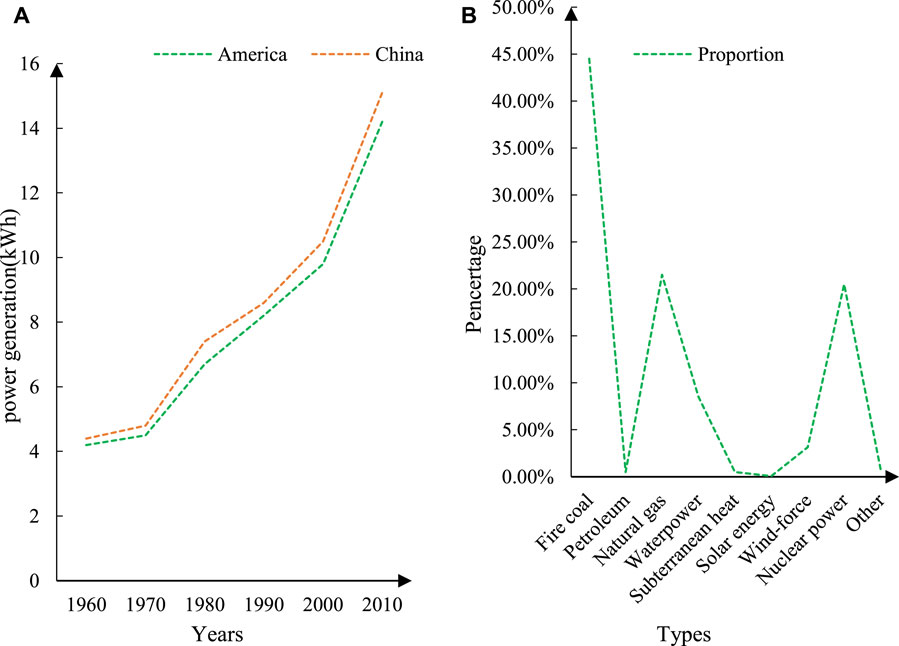
FIGURE 4. Percentage of electricity generated by various types and annual electricity generated by renewable energy sources in the United States. (A) Annual renewable energy generation in China and the United States. (B) Proportion of various PG categories in the United States.
As shown in the figure, Figure 4A showed the annual electricity generation of renewable energy in China and the United States, with a unit of 1,011 kWh. Figure 4B showed the proportion of various types of PG in the United States. It could be seen from the figure that during the period 1960–2010, the annual electricity generation of renewable energy in China and the United States was continuously increasing (Zeng et al., 2018). In the United States, the annual electricity generation from renewable energy was only 4.2 × 1011 kWh in 1960, but by 2010 it increased to 14.2 × 1011 kWh. China had more, from 4.4 × 1011 kWh in 1960 to 15.1 × 1011 kWh in 2010. Among the total PG, coal-fired PG accounted for the largest proportion, accounting for 44.5%. The second was natural gas PG, accounting for 21.5%. In NE PG, WP and solar power took up a certain share. In particular, WP accounted for 3.15%.
While recognizing these favorable trends in the development of WP, people should also recognize their inherent shortcomings. Compared to traditional energy power stations, the PG capacity of wind farms is significantly affected by various environmental factors such as wind and weather, and is characterized by incomplete controllability (García-Nieto et al., 2021). When small-scale wind PG is connected to the grid, the power fluctuation caused by WP is within an acceptable range, and the interference is absorbed by the system, which would not cause too much impact on the safety and stability of the grid (Zhao and Kok Foong, 2022). However, when large-scale distributed wind PG is connected to the grid, power fluctuations caused by changes in WP would have a significant impact on the power system, thereby threatening the security of the grid (Candanedo, 2020).
Firstly, when the proportion of WP is large, the sudden and random nature of this state would seriously affect the stable operation of the power grid, which is mainly caused by distributed WP. On the other hand, the random fluctuation characteristics of WP bring new challenges to the analysis, scheduling, and control of traditional power grids. From this point of view, WP is a potential energy source, but it needs to be properly regulated (Cao and Qian, 2023). With the continuous development of distributed wind energy, it is necessary to study more and deeper grid connected collaborative operation and control technologies for distributed wind energy systems. It is necessary to optimize and adjust the original operation and scheduling mode of the power grid to address the challenges faced by large-scale wind energy access.
After large-scale wind PG is connected to the grid, the active power control for wind PG in the grid can be divided into two types: system level active power control and wind farm active power control. On the basis of WP forecasting, system level active control is mainly based on the forecasting results of wind PG to optimize the scheduling of traditional generating units, including economic scheduling of the active output of conventional generating units. In a wind farm, active power control sends control commands (including active and reactive power) to various units in the wind farm by receiving scheduling commands from the system control layer. The power system would still rely on traditional distribution management systems, feed terminals, and so on (Shi et al., 2023).
The additional system reserve capacity required for wind PG is closely related to the power prediction error of WP. If the prediction error of WP is incorporated into the conventional unit scheduling model, it can significantly reduce the cost of PG. On this basis, this paper constructs a conventional unit active power collaborative optimization scheduling method based on multiple time scales, and takes into account the prediction error of wind farms on this basis, thereby gradually reducing the uncertainties caused by WP grid connection and improving the capacity of the system.
Currently, international research is mainly focused on how to use energy storage to regulate the output of wind farms in order to achieve the maximum benefits under the peak valley electricity price mechanism. However, for power system managers, more research is focused on how to maximize the utility of renewable energy while ensuring the active power balance of the power system, which is also the study of collaborative control strategies with wind PG (Sreedevi et al., 2022). The research results of this article would provide new ideas for improving the efficiency of wind PG in China and reducing the proportion of traditional energy consumption, which had significant academic and application value.
This paper took distributed wind PG connected to the power grid as the object, and only considered the active power control at the system level. Taking this as a starting point, research on collaborative control of new generation distributed NE access to the power grid was conducted. Considering the uncertainty of energy storage and WP operation, the multi time scale active power collaborative optimization problem for conventional units had significant theoretical and practical significance for achieving the safe and efficient utilization of distributed WP and solving the regulation and coordination problems of conventional units at different time levels. The research results of this article would help solve the impact of distributed wind farms on the power system, and promote the collaborative development of wind farms and power systems, so as to enhance the capacity of the power system. The construction of a wind farm time series model suitable for active collaborative optimal scheduling of distributed wind farms was of great significance for scientifically understanding the volatility characteristics of wind PG in multiple time scales (Wang and Lu, 2019).
3.2 Establishment of a suitable wind speed time series model
The establishment of a suitable wind speed time series model is the key to achieving collaborative control of distributed wind farms. In the field of stochastic operation simulation of power grids containing wind farms, the wind speed time series of wind farms is often the most basic and important input data. For example, Monte-Carlo simulation, currently widely used in the above fields, requires a series of long wind speed data as input to obtain accurate wind speed data. The mathematical foundation of Monte-Carlo simulation is the theorem of large numbers in probability theory. Therefore, to obtain accurate simulation results, the required input wind speed series usually need to be up to 105–107 time units (the specific time unit is usually s according to the simulation needs). However, in wind farms, the time units of the measured wind speed series often cannot meet this requirement. In order to ensure the stability of numerical simulation, current research mostly uses a series of measured wind speed time series.
The established model should reflect both the randomness of actual observation data and the statistical characteristics of actual observation data. Therefore, this paper adopted an improved first order Markov Chain (abbreviated as MC for convenience below) based method, and generated a simulated wind speed. The time series simulation of wind speed prediction errors is relatively simple, as long as a random sequence is generated based on its consistent probability distribution.
The MC model includes two aspects: The first is a probability matrix of wind speed state migration that takes into account seasonal characteristics, day and night characteristics, and dry and wet characteristics; the second is the probability matrix of dryness and wetness transfer considering the characteristics of weather dryness and wetness.
This section would compare the statistical characteristics of simulated winds generated using improved first order MC and original first order MC. The main contents of the test include: general statistical parameters, probability distribution, etc.
(1) General statistical parameters
The improved first order MC and the original first order MC were used to simulate the wind speed time series, because it was only an hour’s average. The simulation results were classified by month. General statistics were made for each month on a monthly basis and compared with historical wind time series. In addition, the minimum values of the three wind speeds were all 0 m per second, so the minimum values of the wind series were not separately compared.
As shown in Figure 5A showed the comparison of the average values of different wind speed time series from January to June, and Figure 5B showed the comparison of the average values of different wind speed time series from July to December. The monthly average variation trend of historical wind speed series was relatively significant, while the improved first order MC model’s average wind speed series was more accurate. The difference between the groups of average wind speeds obtained by the original first order MC model was very small, which could not reflect the changes in the monthly average wind speed series in history, thus resulting in significant errors. The simulation accuracy of the model was further improved by introducing seasonal characteristics, dry and wet characteristics, and daily characteristics. The standard deviation comparison of different wind speed time series is shown in Table 1.
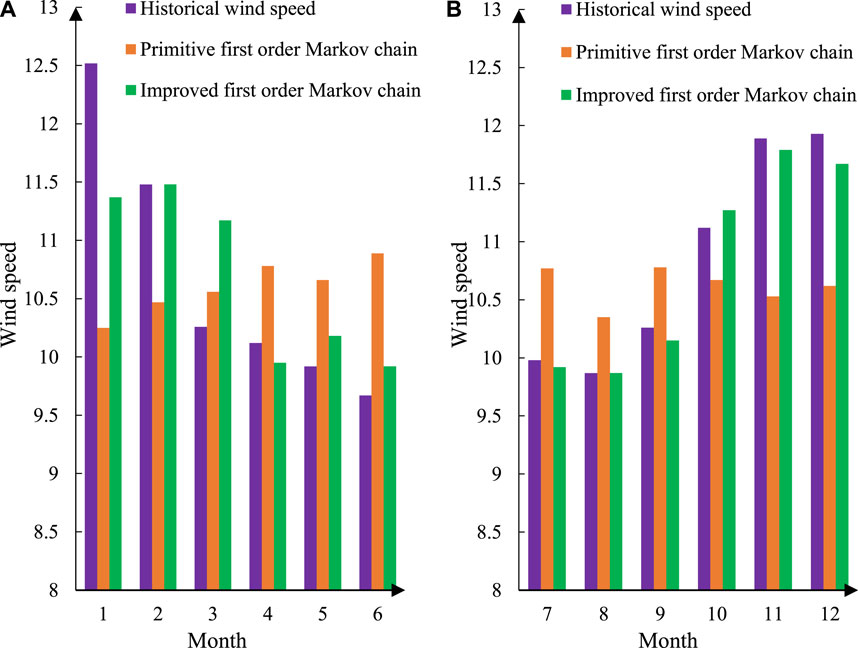
FIGURE 5. Comparison of average values of different wind speed time series. (A) Comparison of mean values of different wind speed time series from January to June. (B) Comparison of mean values of different wind speed time series from July to December.
(2) Probability distribution
It is generally believed that the wind speed should meet the Weibull distribution, so this paper selected the two-parameter Weibull distribution. The probability density function is as follows:
Among them, e and R are the scale and shape parameters of the Weibull distribution, and U is the given wind speed. The maximum likelihood estimation method is used to calculate the scale and shape parameters of the simulated wind speed time series and the historical wind speed time series in different months. The collective results are shown in Figure 6.
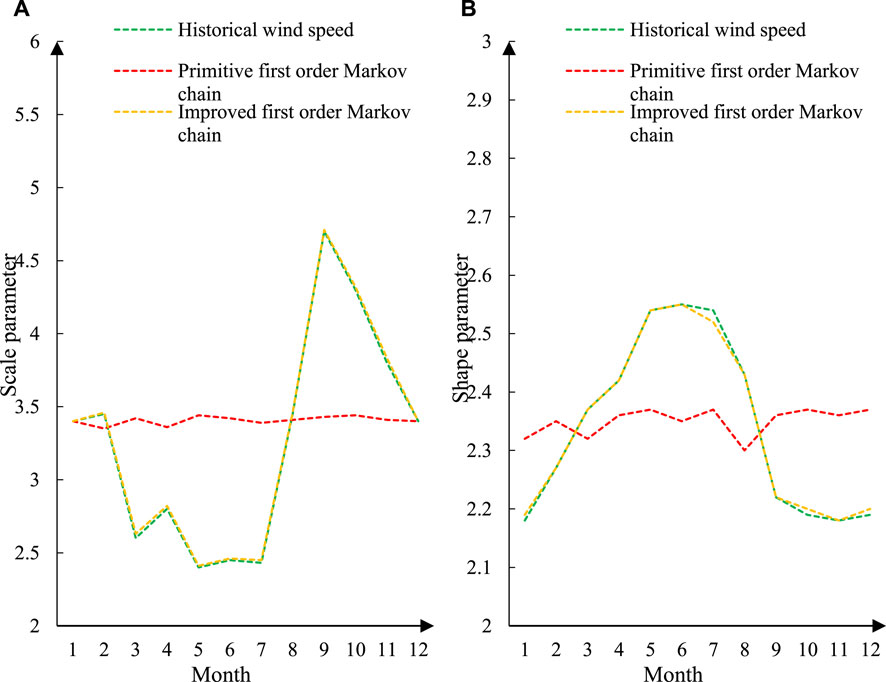
FIGURE 6. Scale and shape parameters for different months. (A) Scale parameters for different months. (B) Shape parameters for different months.
As shown in Figure 6A showed the scale parameters for different months, and Figure 6B showed the shape parameters for different months. It could be seen from the figure that by analyzing the experimental data of the improved first order MC, the wind speed series accurately retained the monthly probability distribution information of the historical wind speed series, and could better maintain the wind field distribution characteristics of the monthly wind field. There was no significant difference in the scale and morphological parameters of the corresponding Weibull distribution between the two. However, a single Markov model that did not consider seasonal characteristics, dry and wet characteristics, and day and night characteristics could not accurately depict the monthly probability distribution of historical wind speeds.
By taking into account the seasonal characteristics, dry and wet characteristics, and sunshine characteristics of the first order MC, this paper established a modified model for the first order MC. This method could effectively improve the accuracy of simulated wind speed series, which was of great significance for improving the accuracy of grid planning and evaluation including wind PG. At the same time, the improvement of this method also facilitated the study of the interaction between wind PG and load, solar photovoltaic PG.
3.3 Optimization model based on rolling scheduling optimization algorithm
Figure 7 shows the calculation time of the rolling scheduling optimization algorithm based on the active set method at different periods in the simulation.
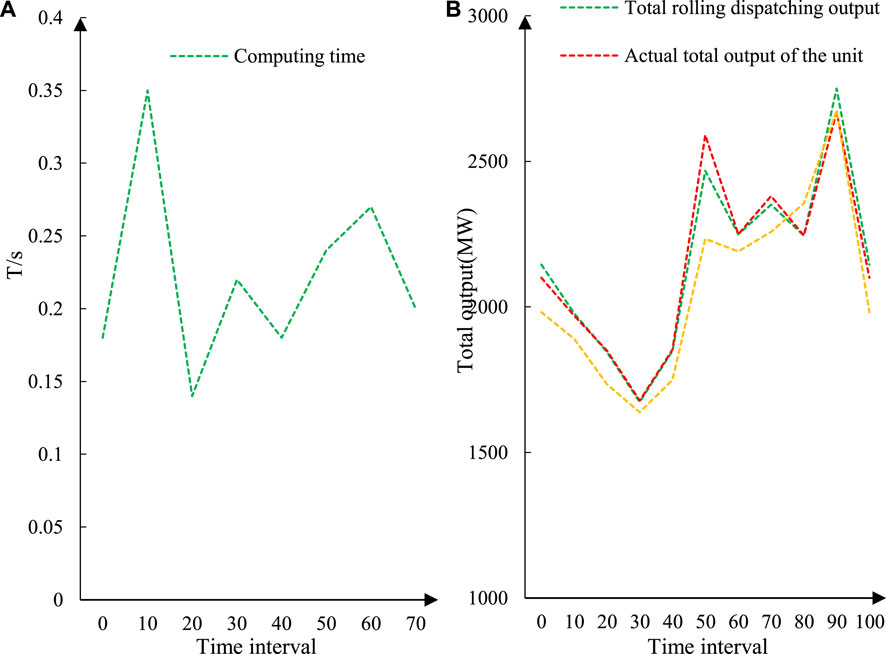
FIGURE 7. Calculation time and rolling scheduling optimization effects for different time periods. (A) Computation time for different time periods. (B) Rolling scheduling optimization effect.
As shown in Figure 7A showed the calculation time for different time periods, and Figure 7B showed the rolling scheduling optimization effect. From the figure, it could be seen that on this basis, the rolling scheduling optimization algorithm was a very effective calculation method. The average operation time of this method was maintained at about 0.2 s, which showed that this method could well achieve online operations. Day ahead scheduling was restricted by the accuracy of wind forecasting, and there was a large error; through rolling adjustment, the error between the total output curve of the unit and the actual total output curve of the unit could be significantly reduced. The results showed that the rolling scheduling optimization algorithm had good optimization effect.
4 Conclusion
With the continuous development and application of NE technologies, distributed NE grid connection has become an important component of modern energy systems. Distributed NE systems have the characteristics of decentralization, renewability, and flexibility, but they also face challenges in power system stability and security. Therefore, how to achieve the coordinated operation of distributed NE and traditional power systems and ensure the stability and security of power systems has become an urgent issue to be solved. This paper discussed the temporal wind speed model. The year was divided into 12 cycles, and the seasonal and daily characteristics of wind speed were introduced into the first order Markov model; on this basis, the dry and wet characteristics of wind were introduced, and then an improved first order MC model was proposed to simulate the timing of wind. Experiments showed that this new model made the simulated wind speed data more accurate. On this basis, this paper also designed a rolling scheduling optimization method and explains its initialization strategy. The numerical simulation results showed that the method was effective: After adjusting the operation plan, the method could effectively reduce the error between the total power curve of the unit and the actual power curve of the unit.
Data availability statement
The original contributions presented in the study are included in the article/Supplementary Material, further inquiries can be directed to the corresponding author.
Author contributions
YoL: Writing original draft; JSu: Writing—review and editing; JH: Data curation; RC: Methodology; YiL: Resources; JSh: Software.
Conflict of interest
Authors YoL, JSu, JH, RC, YiL, and JSh were employed by Yunnan Power Grid Co., Ltd.
Publisher’s note
All claims expressed in this article are solely those of the authors and do not necessarily represent those of their affiliated organizations, or those of the publisher, the editors and the reviewers. Any product that may be evaluated in this article, or claim that may be made by its manufacturer, is not guaranteed or endorsed by the publisher.
References
Amrit, P., Chaudhari, K., Long, C., and Hoay, B. G. (2018). Peer-to-peer energy trading in a prosumer-based community microgrid: A game-theoretic model. IEEE Trans. Industrial Electron. 66 (8), 6087–6097. doi:10.1109/TIE.2018.2874578
Candanedo, S. (2020). Reactive power optimization of power system based on distributed cooperative particle swarm optimization algorithm. Distrib. Process. Syst. 1 (Issue 2), 46–53. doi:10.1109/DDCLS52934.2021.9455680
Cao, Z., and Qian, L. (2023). Crowding effect of institutional openness based on the big data algorithm on the efficiency of new energy technology innovation. Front. Bioeng. Biotechnol. 11, 1178737. doi:10.3389/fbioe.2023.1178737
Chen, H., Shang, Y., and Sun, K. (2013). Multiple Fault condition recognition of gearbox with sequential hypothesis test. Mech. Syst. Signal Process. 40 (2), 469–482. doi:10.1016/j.ymssp.2013.06.023
Fabio, M., and Pierre, P. (2018). Energy collectives: A community and fairness based approach to future electricity markets. IEEE Trans. Power Syst. 34 (5), 3994–4004. doi:10.1109/TPWRS.2018.2808961
Fang, Y., Chen, P., Han, T., Zhang, X., and Zhou, T. (2022). Parental attachment and cyberbullying among college students: the mediating role of loneliness and the moderating role of interdependent self. Neural Comput. Appl., 1–9. doi:10.1007/s12144-022-04046-2
García-Nieto, P. J., García-Gonzalo, E., Paredes-Sánchez, J. P., and Bernardo Sánchez, A. (2021). A new hybrid model to foretell thermal power efficiency from energy performance certificates at residential dwellings applying a Gaussian process regression. Neural Comput. Applic 33, 6627–6640. doi:10.1007/s00521-020-05427-z
Guneet, B., Kumar Venayagamoorthy, G., Singh, R., Brooks, R. R., and Wang, K. C. (2018). Review of Internet of Things (IoT) in electric power and energy systems. IEEE Internet Things J. 5 (2), 847–870. doi:10.1109/JIOT.2018.2802704
Han, L., Morstyn, T., and McCulloch, M. (2018). Incentivizing prosumer coalitions with energy management using cooperative game theory. IEEE Trans. Power Syst. 34 (1), 303–313. doi:10.1109/tpwrs.2018.2858540
Kacper, S. (2018). Conceptualizing energy democracy. Environ. Polit. 27 (1), 21–41. doi:10.1080/09644016.2017.1387294
Kumar, A., Khan, S. B., Pandey, S. K., Shankar, A., Maple, C., Mashat, A. A., et al. (2023). Development of a cloud-assisted classification technique for the preservation of secure data storage in smart cities. J. Cloud Comput. 12 (1), 92. doi:10.1186/s13677-023-00469-9
Lasseter Robert, H. (2019). Zhe chen and dinesh pattabiraman. "Grid-forming inverters: A critical asset for the power grid. IEEE J. Emerg. Sel. Top. Power Electron. 8 (2), 925–935. doi:10.1109/JESTPE.2019.2959271
Liu, H., Zhang, Y., and Yang, T. (2018). "Blockchain-enabled security in electric vehicles cloud and edge computing." IEEE Netw. 32, 78–83. doi:10.1109/mnet.2018.1700344
Luo, F., ZhaoDong, Y., Liang, G., Murata, J., and Zhao, X. (2018). A distributed electricity trading system in active distribution networks based on multi-agent coalition and blockchain. IEEE Trans. Power Syst. 34 (5), 4097–4108. doi:10.1109/tpwrs.2018.2876612
Lv, Z., Han, Y., AmitSingh, K., Manogaran, G., and Lv, H. (2020). Trustworthiness in industrial IoT systems based on artificial intelligence. IEEE Trans. Industrial Inf. 17 (2), 1496–1504. doi:10.1109/tii.2020.2994747
Pierluigi, S., De Marco, G., Rolan, A., and Loia, V. (2019). A survey and evaluation of the potentials of distributed ledger technology for peer-to-peer transactive energy exchanges in local energy markets. IEEE Syst. J. 13 (3), 3454–3466. doi:10.1109/jsyst.2019.2903172
Shankar, A., and Maple, C. (2023). Securing the Internet of Things-enabled smart city infrastructure using a hybrid framework. Comput. Commun. 205, 127–135. doi:10.1016/j.comcom.2023.04.008
Shi, Y., Li, H., Fu, X., Luan, R., Wang, Y., Wang, N., et al. (2023). Self-powered difunctional sensors based on sliding contact-electrification and tribovoltaic effects for pneumatic monitoring and controlling. Nano Energy 110, 108339. doi:10.2139/ssrn.4340707
Silva Fernando, A. (2018). Smart grid handbook [book news]. IEEE Ind. Electron. Mag. 12 (1), 59–60. doi:10.1109/mie.2018.2791097
Sreedevi, A. G., Nitya Harshitha, T., Vijayan, S., and Shankar, P. (2022). Application of cognitive computing in healthcare, cybersecurity, big data and IoT: A literature review. Inf. Process. Manag. 59 (2), 102888. doi:10.1016/j.ipm.2022.102888
Thomas, M., Farrell, N., Darby, S. J., and McCulloch, M. D. (2018). Using peer-to-peer energy-trading platforms to incentivize prosumers to form federated power plants. Nat. energy 3 (2), 94–101. doi:10.1038/s41560-017-0075-y
Wang, Q., and Lu, P. (2019). Research on application of artificial intelligence in computer network technology. Int. J. Pattern Recognit. Artif. Intell. 33 (5), 1959015. doi:10.1142/s0218001419590158
Wang, S., Taha, A. F., Wang, J., Kvaternik, K., and Hahn, A. (2019). Energy crowdsourcing and peer-to-peer energy trading in blockchain-enabled smart grids. IEEE Trans. Syst. Man, Cybern. Syst. 49 (8), 1612–1623. doi:10.1109/tsmc.2019.2916565
Yang, Li, Yang, Z., Li, G., Zhao, D., and Tian, W. (2018). Optimal scheduling of an isolated microgrid with battery storage considering load and renewable generation uncertainties. IEEE Trans. Industrial Electron. 66 (2), 1565–1575. doi:10.1109/tie.2018.2840498
Yin, L., Li, X., Gao, L., Lu, C., and Zhang, Z. (2017). A novel mathematical model and multi-objective method for the low-carbon flexible job shop scheduling problem. Sustain. Comput. Inf. Syst. 13 (3), 15–30. doi:10.1016/j.suscom.2016.11.002
Zeng, L., Shi, J., Luo, J., and Chen, H. (2018). Silver sulfide anchored on reduced graphene oxide as A high-performance catalyst for CO2 electroreduction. J. Power Sources 398, 83–90. doi:10.1016/j.jpowsour.2018.07.049
Keywords: distributed new energy, coordinated operation control, technology, artificial intelligence algorithms, coordinated development
Citation: Lu Y, Sun J, Hu J, Chen R, Liao Y and Shang J (2023) Investigation on the coordinated operation control technology of distributed new energy grid connection using artificial intelligence algorithms. Front. Energy Res. 11:1253890. doi: 10.3389/fenrg.2023.1253890
Received: 06 July 2023; Accepted: 15 August 2023;
Published: 14 September 2023.
Edited by:
Xin Ning, Chinese Academy of Sciences (CAS), ChinaCopyright © 2023 Lu, Sun, Hu, Chen, Liao and Shang. This is an open-access article distributed under the terms of the Creative Commons Attribution License (CC BY). The use, distribution or reproduction in other forums is permitted, provided the original author(s) and the copyright owner(s) are credited and that the original publication in this journal is cited, in accordance with accepted academic practice. No use, distribution or reproduction is permitted which does not comply with these terms.
*Correspondence: Yonglin Lu, bHV5b25nbGluXzA1NDhAMTYzLmNvbQ==
 Yonglin Lu
Yonglin Lu Jinyong Sun
Jinyong Sun